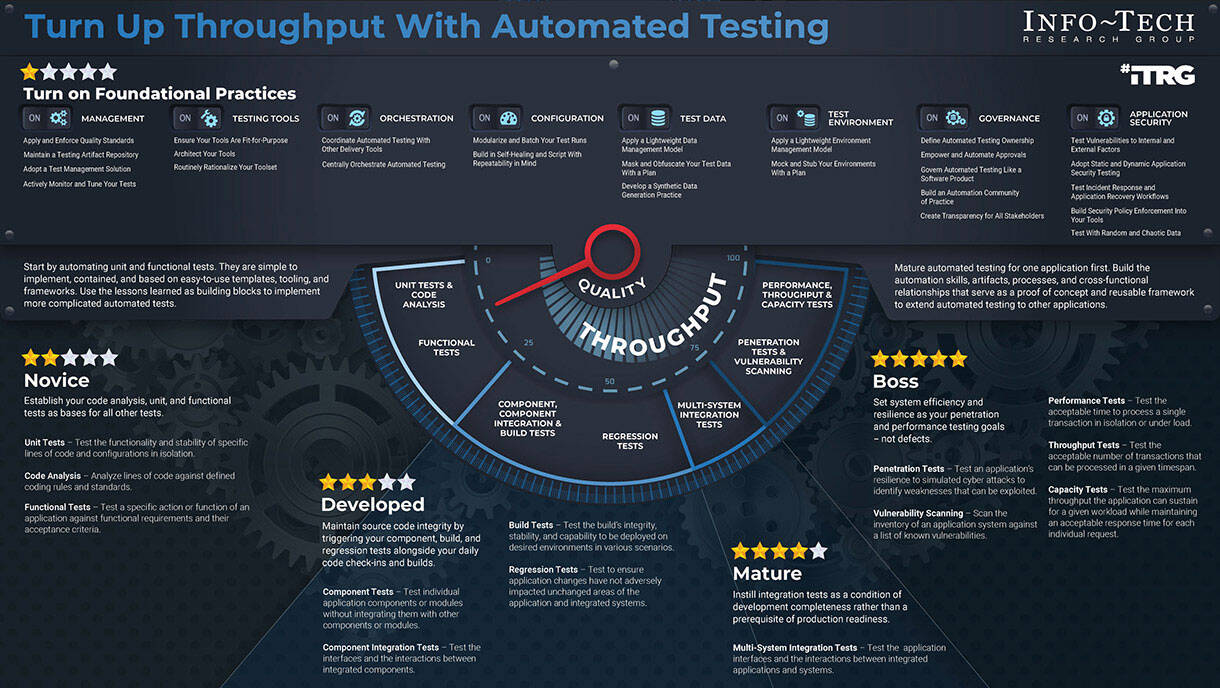Automate Testing to Get More Done

- Today’s rapidly changing software products and operational processes create mounting pressure on software delivery teams to release new features and changes quickly while meeting high and demanding quality standards.
- Most organizations see automated testing as a solution to meet this demand alongside their continuous delivery pipeline. However, they often lack the critical foundations, skills, and practices that are imperative for success.
- The technology is available to enable automated testing for many scenarios and systems, but industry noise and an expansive tooling marketplace create confusion for those interested in adopting this technology.
Our Advice
Critical Insight
- Good automated testing improves development throughput. No matter how quickly you put changes into production, end users will not accept them if they do not meet quality standards. Escaped defects, refactoring, and technical debt can significantly hinder your team’s ability to deliver software on time and on budget. In fact, 65% of organizations saw a reduction of test cycle time and 62% saw reductions in test costs with automated testing (Sogeti, World Quality Report 2020–21).
- Start automation with unit and functional tests. Automated testing has a sharp learning curve, due to either the technical skills to implement and operate it or the test cases you are asked to automate. Unit tests and functional tests are ideal starting points in your automation journey because of the available tools and knowledge in the industry, the contained nature of the tests you are asked to execute, and the repeated use of the artifacts in more complicated tests (such as performance and integration tests). After all, you want to make sure the application works before stressing it.
- Automated testing is a cross-functional practice, not a silo. A core component of successful software delivery throughput is recognizing and addressing defects, bugs, and other system issues early and throughout the software development lifecycle (SDLC). This involves having all software delivery roles collaborate on and participate in automated test case design, configure and orchestrate testing tools with other delivery tools, and proactively prepare the necessary test data and environments for test types.
Impact and Result
- Bring the right people to the table. Automated testing involves significant people, process and technology changes across multiple software delivery roles. These roles will help guide how automated testing will compliment and enhance their responsibilities.
- Build a foundation. Review your current circumstances to understand the challenges blocking automated testing. Establish a strong base of good practices to support the gradually adoption of automated testing across all test types.
- Start with one application. Verify and validate the automated testing practices used in one application and their fit for other applications and systems. Develop a reference guide to assist new teams.
Automate Testing to Get More Done Research & Tools
Besides the small introduction, subscribers and consulting clients within this management domain have access to:
1. Start here – read the Executive Brief
Read our concise Executive Brief to find out why you should automate testing, review Info-Tech’s methodology, and understand the four ways we can support you in completing this project.
- Automate Testing to Get More Done Storyboard
2. Adopt good automated testing practices
Develop and implement practices that mature your automated testing capabilities.
- Automated Testing Quick Reference Template
Infographic

Workshop: Automate Testing to Get More Done
Workshops offer an easy way to accelerate your project. If you are unable to do the project yourself, and a Guided Implementation isn't enough, we offer low-cost delivery of our project workshops. We take you through every phase of your project and ensure that you have a roadmap in place to complete your project successfully.
1 Adopt Good Automated Testing Practices
The Purpose
Understand the goals of and your vision for your automated testing practice.
Develop your automated testing foundational practices.
Adopt good practices for each test type.
Key Benefits Achieved
Level set automated testing expectations and objectives.
Learn the key practices needed to mature and streamline your automated testing across all test types.
Activities
1.1 Build a foundation.
1.2 Automate your test types.
Outputs
Automated testing vision, expectations, and metrics
Current state of your automated testing practice
Ownership of the implementation and execution of automated testing foundations
List of practices to introduce automation to for each test type
Buying Options
Automate Testing to Get More Done
Client rating
Cost Savings
Days Saved
IT Risk Management · IT Leadership & Strategy implementation · Operational Management · Service Delivery · Organizational Management · Process Improvements · ITIL, CORM, Agile · Cost Control · Business Process Analysis · Technology Development · Project Implementation · International Coordination · In & Outsourcing · Customer Care · Multilingual: Dutch, English, French, German, Japanese · Entrepreneur
Tymans Group is a brand by Gert Taeymans BV
Gert Taeymans bv
Europe: Koning Albertstraat 136, 2070 Burcht, Belgium — VAT No: BE0685.974.694 — phone: +32 (0) 468.142.754
USA: 4023 KENNETT PIKE, SUITE 751, GREENVILLE, DE 19807 — Phone: 1-917-473-8669
Copyright 2017-2022 Gert Taeymans BV